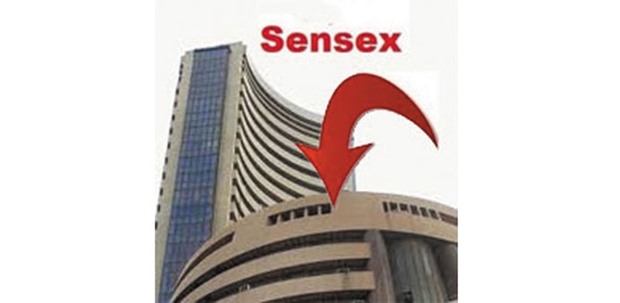Indian stocks fell in a volatile trading, tracking declines around the world, as investors turned cautious before key events including the US Federal Reserve meeting.
Tata Motors, the owner of Jaguar Land Rover, dropped for the first time in seven days. Infosys, the second-largest software services provider, was the top loser this week on the S&P BSE Sensex. State Bank of India (SBI) slid for a second day. Tata Steel fell the most in about three weeks.
The Sensex lost 0.5%, or 127.71 points, to 26,635.75 at the close in Mumbai, its second day of losses. It earlier rose as much as 0.8%. The gauge slid 0.8% this week, ending two weeks of advances. The retreat comes before key events such as the Fed’s meeting next week, followed by the UK’s referendum on EU membership on June 23, which have the potential to roil markets.
“Brexit is weighing down on the markets globally and that’s pretty much weighing on the Indian markets as well,” Nitasha Shankar, vice-president for equity research at Yes Securities Ltd in Mumbai, said in an interview with Bloomberg TV India. “Fortunately, for us on a fundamental side we are placed quite strongly. So, the impact is not as significant. But until such time this event is behind us we will continue to see some kind of pressure on the index.”
The MSCI All-Country World Index headed for its steepest two-day decline since May 4, led by commodity producers and financial companies. The Stoxx Europe 600 Index was down 1.8%. The MSCI Asia Pacific Index lost 0.9%.
The Sensex rose to a seven-month high on Wednesday after the Reserve Bank of India (RBI) said this week it remains willing to cut borrowing costs as long as conditions allow, and as the odds of a rate increase by the Fed receded.
The Sensex has risen 16% from a low reached in February, putting India on course to become the first among markets valued at more than $1tn to crawl back from a bear market this year. Global investors bought more Indian shares than they sold for an 11th straight day, taking net purchases since April 1 to $1.5bn.
India’s monsoon, which accounts for four-fifths of the country’s rainfall, reached the mainland in southern Kerala state on Wednesday. The government is counting on above-normal precipitation this year to help control food prices, boost farm production and ease a drinking-water shortage caused by back-to-back droughts. Agriculture accounts for roughly 18% of India’s gross domestic product.
The monsoon is key to sustaining India’s world-beating economic growth, which accelerated a faster-than-estimated 7.9% in the March quarter. The data cemented the nation’s position as a bright spot among emerging markets as China slows while Russia and Brazil see contractions.
Meanwhile the rupee closed marginally lower against the US dollar yesterday, as traders avoided long positions ahead of the key economic data from global and domestic markets due next week.
The home currency closed at 66.76, down 0.06% from its previous close of 66.72. The rupee opened at 66.81 per US dollar and touched a high and a low of 66.74 and 66.88, respectively.
Most Asian currencies closed lower. South Korean won was down 0.81%, Malaysian ringgit 0.65%, Taiwan dollar 0.31%, Philippines peso 0.22%, Singapore dollar 0.18%, Thai baht 0.15%, China offshore 0.14% and Indonesian rupiah 0.05%. However, Japanese yen was up 0.25% and China renminbi 0.14%.
India’s 10-year bond yield closed at 7.492%, compared with its Thursday’s close of 7.487%.
So far this year, the rupee has weakened 0.91%, while foreign institutional investors (FIIs) have bought $2.74bn from the local equity market and sold $1.20bn in the debt market.



